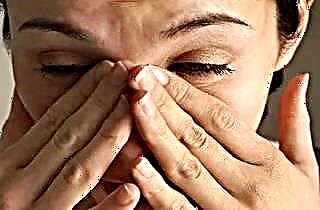A cyst is found in the nasal sinus in 90% of cases by accident. This is a benign formation with which you can live your whole life, without even knowing about its presence. But sometimes the cyst becomes inflamed, filled with pus and can manifest itself as extremely unpleasant symptoms. Then it becomes necessary to treat or remove it.
True or False?
 In medicine, such concepts as a true false cyst are distinguished. A true cyst in the nose or sinuses is a fluid-filled cavity, the walls of which are formed by an overgrown mucous membrane. It appears due to the blockage of the ducts through which the secret produced by the mucous glands comes out. The cause of the blockage itself is most often chronic inflammatory processes, due to which the mucous membrane thickens and partially changes its structure.
In medicine, such concepts as a true false cyst are distinguished. A true cyst in the nose or sinuses is a fluid-filled cavity, the walls of which are formed by an overgrown mucous membrane. It appears due to the blockage of the ducts through which the secret produced by the mucous glands comes out. The cause of the blockage itself is most often chronic inflammatory processes, due to which the mucous membrane thickens and partially changes its structure.
If the cyst is small and not inflamed, it is filled with transparent mucus and does not bother the person at all. Its growth rate depends on many reasons, most of which have not been identified. Therefore, having small cysts of the sinuses, a person can live a whole life and never know about it.
When a cyst becomes inflamed, it fills with pus, which rapidly increases. When a rupture occurs, pus flows into the sinuses, and then diseases such as sinusitis, frontal sinusitis, etc. appear. Therefore, the question of whether it is dangerous to have a cyst and whether urgent removal is necessary, the answer can only be given by a doctor after the diagnosis.
A pseudocyst usually grows in the maxillary sinuses and is associated with chronic inflammation of the tissues or dental roots of the upper jaw. Its lower wall is not a mucous lining, but just maxillary tissues. If the tooth, over which the cyst of the nasal sinus has formed, is affected by caries, the infection can penetrate into the cavity filled with fluid, provoke inflammation and suppuration.
Causes provocateurs
In a healthy person, all mucous glands function normally and moderately secrete a secret that moisturizes the mucous membranes. With respiratory illness or exposure to external stimuli, the amount of mucus secreted increases. When too much of it accumulates in the sinuses and stagnation forms, blockage of the ducts can occur, which is the main cause of cyst formation.
 Such factors can provoke an abundant secretion of mucus:
Such factors can provoke an abundant secretion of mucus:
- persistent allergic reactions;
- chronic diseases of the nose and sinuses (rhinitis, sinusitis, etc.);
- persistent colds;
- asymmetrical structure of the face;
- severe curvature of the nasal septum;
- caries, inflammation of the tissues and teeth of the upper jaw;
- polyps or chronically inflamed adenoids.
Sometimes poor working conditions (polluted or hot air, inhalation of chemical vapors, etc.) contribute to mucus stagnation and the formation of paranasal sinus cysts. And even if the air in the apartment or workroom is constantly too dry, this also leads to hyperactivity of the mucous membranes, which are trying to compensate for the lack of moisture.
Alarming symptoms
If a cyst in the sinus of a person does not bother or increase in size, you should not touch it. Even if it manifested itself on an X-ray taken for another reason, there is no need for special treatment, and even more so for an operation. It's another matter when you don't even know about the diagnosis yet, but the following symptoms began to bother you:
 persistent nasal congestion;
persistent nasal congestion;- feeling of pressure and / or fullness to the right or left of the bridge of the nose;
- an unpleasant feeling of something extra in the upper jaw area;
- pain and / or discomfort when chewing food;
- pain syndrome when diving or flying on an airplane;
- severe headaches that intensify when lowering the head down;
- frequent exacerbations of chronic sinusitis with the release of pus;
- persistent profuse rhinitis, for no apparent reason.
Only a doctor can diagnose the presence of a cyst. It is rarely visible on external examination. Moreover, more often the doctor discovers a cyst on the left, since it is more convenient for him to examine this nasal passage. But, fortunately, now we have at our disposal high-tech examination methods, which are used for diagnostics.
Diagnosis of a cyst
The easiest way to find a cyst is with an X-ray. On it you can see the size, shape and location of the formation in the left or right sinus. If it does not pose a danger to the patient, you can limit yourself to this. But when a cyst of the left or right sinus gives the unpleasant symptoms listed above, one image is not enough, other studies are needed:
 MRI or computed tomography - allow you to draw conclusions about the structure of education, consider it in detail;
MRI or computed tomography - allow you to draw conclusions about the structure of education, consider it in detail;- endoscopy of the maxillary sinuses - done when the cyst in the sinus is small, at the same time you can take a tissue sample for a biopsy or immediately remove it;
- sinusography is a type of X-ray, in front of which a contrast is preliminarily introduced into the cavity of the right or left sinus, clearly showing the outlines of the formation;
- biopsy - a study of tissue samples that form cysts in the nose, which allows you to determine whether this formation is true or false, as well as to analyze the fluid that fills it.
Based on the results of the examination, a decision is made on how to treat the cyst or the need to remove it. If no measures are taken, subsequently an inflamed or ruptured cyst can cause purulent inflammation of the sinuses and even decay of the bones of the nose and upper jaw.
Traditional methods
Today popular methods of treatment are trying to be used for any disease. In this situation, they are absolutely useless. Since the cyst is located in a closed sinus, to which there is no access from the outside, it is impossible to influence it intensively with traditional medicine. Therefore, if the formation is already inflamed and / or filled with pus, such treatment can only worsen the situation, especially if warming is applied.
 It is worth using natural remedies only to eliminate the causes that can provoke the growth of a cyst and as a prevention of its appearance. That is, to combat allergies, rhinitis and strengthen the immune system, which will make it possible to catch respiratory and viral diseases less often. Moreover, just the majority of those methods of treatment that are usually used, in this case, can be harmful.
It is worth using natural remedies only to eliminate the causes that can provoke the growth of a cyst and as a prevention of its appearance. That is, to combat allergies, rhinitis and strengthen the immune system, which will make it possible to catch respiratory and viral diseases less often. Moreover, just the majority of those methods of treatment that are usually used, in this case, can be harmful.
Therefore, let's start with what you can't do:
- use essential oils for inhalation;
- do rinsing with herbal decoctions or infusions;
- use beekeeping products for treatment: honey, propolis, etc.;
- bury the nose with alcoholic tinctures and solutions;
- use the juice or pulp of aloe before identifying the nature of the formation.
Mummy tincture (in water with glycerin), juice from cyclamen tubers (diluted with water 1: 4) or pure golden mustache juice, which can be dripped 3-4 drops 2-3 times a day, will help to heal the nasal mucosa, relieve inflammation and swelling. If the cyst bothers you, you will have to take more drastic measures.
Removal of the cyst
Many people believe that if a cyst has already burst or has been accidentally punctured (for example, during a puncture of the maxillary sinus), and the fluid has flowed out, then it will not appear. This opinion is erroneous - if the cyst body itself remains, then after a while the integrity of the membrane is restored, and it is again filled with fluid or pus.
Therefore, if a decision has already been made that the formation should be removed, it is better to do it surgically.Moreover, the achievements of modern medicine make it possible to do this bloodlessly and practically painlessly. Usually, after removal at the same place, the cyst no longer forms, especially if the manipulation is performed using a laser, which simultaneously cauterizes the tissue at the site of the operation.

The most common technologies today are the Cadwell-Luc technique or endoscopic removal. All these manipulations can be performed under both local and general anesthesia. The choice of the removal method is individual. It depends on the type and location of the cyst, the presence or absence of special equipment, the qualifications of the surgeon.
- The Cadwell-Luc technique is used to remove a cyst deep in the right or left sinus. It consists in the fact that a small incision is made under the upper lip with a conventional or laser scalpel, through which access to the sinus cavity opens, the cyst is excised and a small suture is applied. The advantage of the method is that it allows you to remove a cyst with deep localization. Minus - the integrity of the sinus mucosa is disrupted, due to which chronic sinusitis or rhinitis may subsequently develop.
- Endoscopic removal. Much less traumatic method. An endoscope is inserted through the nasal passage, which penetrates through a small opening into the maxillary sinus and burns out the formation with a laser. The operation is practically bloodless, since the edges of the wounds are immediately sealed and then quickly overgrown. This is the main advantage of the method. The downside is that it is impossible to remove purulent formations in this way.
 Removal of a dental cyst can be carried out in any of these ways, it all depends on its size and condition. Before determining the date of the operation, the doctor prescribes the necessary tests to make sure that there are no active inflammatory processes and other contraindications.
Removal of a dental cyst can be carried out in any of these ways, it all depends on its size and condition. Before determining the date of the operation, the doctor prescribes the necessary tests to make sure that there are no active inflammatory processes and other contraindications.
The operation is contraindicated in pregnancy, blood clotting disorders, cardiovascular insufficiency, systemic diseases (AIDS, lupus, etc.), autoimmune diseases. Manipulations will have to be postponed for the period of menstruation, a period of exacerbation of chronic diseases, if the patient has recently had a viral or respiratory disease.
In the postoperative period, it is necessary to strictly follow all the doctor's prescriptions, take prescribed medications, and properly care for the nasal cavity.
During the month, you need to protect yourself from hypothermia, drafts and avoid active physical activity. With strict adherence to the instructions given by the doctor, the operation usually takes place without complications, and the body quickly recovers.

 persistent nasal congestion;
persistent nasal congestion; MRI or computed tomography - allow you to draw conclusions about the structure of education, consider it in detail;
MRI or computed tomography - allow you to draw conclusions about the structure of education, consider it in detail;

